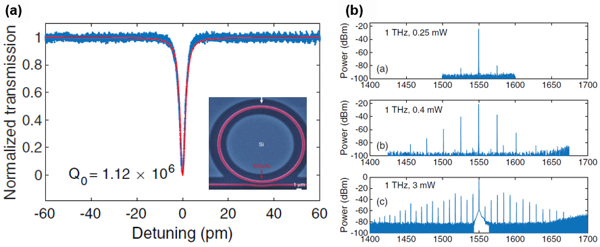Driven by cost-effective and massive mature CMOS technology, silicon photonics (SiPh) based on Si-on-insulator (SOI) substrates has made a big success to provide various photonics integrated circuits (PICs) building blocks from individual devices to systems in high-volume manufacturing, including nanowaveguide-based passive components, Si PN junction-based modulators, SiGe detectors, and even laser sources based on III-V/Si heterogeneous integration technique.
Undoubtedly, SiPh plays a central role in today's PICs community and has found applications in a large number of areas such as optical interconnects, telecommunications, computing, and so on. Meanwhile, integrated nonlinear photonics ?a counterpart of conventional linear integrated photonics ? has emerged as a new direction for scientific exploration over the last decade, primarily due to its unqie ability to generate on-chip new classes of coherent, ultra-broadband light sources (e.g., microcombs), and consequently opened up new perspectives for a wide variety of applications such as coherent datacom, precision measurement, metrology, quantum optics, etc.
In particular, recent breakthroughs in ultralow-loss nanophotonics have enabled high-efficiency nonlinear operation at dramatically reduced power levels of milliwatts or even lower and really allowed the possibility of fully chip-scale nonlinear implementation that is capable of both nonlinear signal generation and processing.
In such context, naturally, it is desirable to incorporate the intriguing nonlinear functionalities into conventional mature SiPh platform towards fully-integrated nonlinear engines for innovative applications. Unfortunately, Si has inherent bottlenecks in nonlinearity (e.g., two-photon absorption and the absence of the 2nd nonlinearity) at the most important telecom bands, hampering its application in efficient nonlinear PICs.
Therefore, it has to be necessary to search for a suitable material candidate to combine its potential excellent nonlinear properties with existing SiPh for fully functional nonlinear chips. More importantly, this combination should fulfill the requirement of compatibility in both power budget and fabrication technology for future scalable and advanced integration.
To address the above issue, in this article, the researchers from the Prof. John E. Bowers' group at the University of California, Santa Barbara experimentally realized high-Q AlGaAs microresonators heterogeneously integrated on Si waveguides on the SOI substrate and demonstrated low-power-threshold microcomb generation at telecom bands on this AlGaAs-SOI platform. Related results were published in Photonics Research Vol. 10, Issue 2, 2022 (Weiqiang Xie, Chao Xiang, Lin Chang, Warren Jin, Jonathan Peters, John E. Bowers. Silicon-integrated nonlinear III-V photonics[J]. Photonics Research, 2022, 10(2): 02000535).
They report a vertical heterogeneous integration approach to bridge high-index, highly-nonlinear AlGaAs, which has been termed as "the silicon of nonlinear optical materials", and SiPh on SOI platform for the development of power-efficiency, scalable Si nonlinear photonics in future, as shown in Fig. 1.

Fig. 1. (a) Schematic of the AlGaAs-Si integration architecture. (b) Vertical heterogeneous integration process using wafer bonding technique.
In this work, the authors propose a general architecture in which the independent Si and AlGaAs PICs layers can be coupled efficiently with each other. Meanwhile, this architecture possesses compatibility in both function and fabrication. They develop a reliable fabrication technology using the wafer bonding method (Fig. 1b), which can integrate high-quality (Q over 106) AlGaAs microresonators with SiPh on a heterogeneous SOI platform.
Such heterogeneous integration can be realized in a back-end-of-line integration approach at relatively low processing temperature (≤200°C) and hence fully compatible with existing passive/active Si PICs (waveguides, Si PN junction-based modulators, SiGe detectors, III-V/Si lasers, etc.) for developing large-scale and advanced applications. The fabricated device shows submilliwatt-threshold (~ 0.25 mW) frequency comb generation at the telecom bands (~1550 nm) on the SOI platform for the first time, as shown in Fig. 2.

Fig. 2. (a) Measured Q factor of AlGaAs microring on SOI. (b) Kerr frequency comb generated in AlGaAs microring with pump/output accessed via Si waveguides.
This work bridges the superior nonlinear AlGaAs and the mature SiPh in seamless integration and demonstrates the compatibility in both fabrication technology and operation power budget between the two classes of photonic functionalities. This would enable further scalable and complex nonlinear PICs and miniaturized systems hosted in the SOI platform, by leveraging mature SiPh technology. The result provides a promising route towards fully-integrated nonlinear chips and propels the related fundamental research and applications into a new phase.
"This work successfully adds the missing building blocks ? nonlinear functionalities ? to the current Si photonics platform, by integrating AlGaAs, which is well-known for its both strong second- and third-order nonlinearities, on SOI substrate", Dr. Weiqiang Xie comments, "The technique itself is straightforward but very effective and could be extended to construct a complex structure that consists of more functional SiPh and AlGaAs nonlinear functions without limitations in processing. Thus, we can see that this work will open many new possibilities for future nonlinear PICs in many exciting application areas."
Currently, Prof. John E. Bowers' group is making an effort on the further improvement of Q factor of AlGaAs microresonators on SOI platform thus to lower the power threshold for nonlinear processes and to investigate the approaches for generating soliton microcombs. Meanwhile, more building blocks from Si and AlGaAs photonics will be integrated together for fully chip-scale nonlinear signal generation and processing. The relevant applications based on integrated microcombs are also under development.


